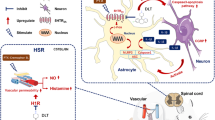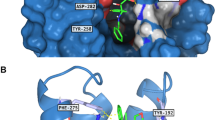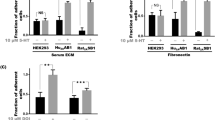Abstract
Aim:
Severe painful sensory neuropathy often occurs during paclitaxel chemotherapy. Since paclitaxel can activate mast cell and basophils, whereas quercetin, a polyphenolic flavonoid contained in various plants, which can specifically inhibit histamine release as a mast cell stabilizer. In this study we explore whether quercetin could ameliorate paclitaxel-induced neuropathic pain and elucidated the underlying mechanisms.
Methods:
Quercetin inhibition on histamine release was validated in vitro by detecting histamine release from rat basophilic leukemia (RBL-2H3) cells stimulated with paclitaxel (10 μmol/L). In the in vivo experiments, rats and mice received quercetin (20, 40 mg·kg-1·d-1) for 40 and 12 d, respectively. Meanwhile, the animals were injected with paclitaxel (2 mg/kg, ip) four times on d 1, 3, 5 and 7. Heat hyperalgesia and mechanical allodynia were evaluated at the different time points. The animals were euthanized and spinal cords and dorsal root ganglions were harvested for analyzing PKCε and TRPV1 expression levels. The plasma histamine levels were assessed in rats on d 31.
Results:
Pretreatment with quercetin (3, 10, 30 μmol/L) dose-dependently inhibited excessive histamine release from paclitaxel-stimulated RBL-2H3 cells in vitro, and quercetin administration significantly suppressed the high plasma histamine levels in paclitaxel-treated rats. Quercetin administration dose-dependently raised the thresholds for heat hyperalgesia and mechanical allodynia in paclitaxel-treated rats and mice. Furthermore, quercetin administration dose-dependently suppressed the increased expression levels of PKCε and TRPV1 in the spinal cords and DRGs of paclitaxel-treated rats and mice. Moreover, quercetin administration may inhibited the translocation of PKCε from the cytoplasm to the membrane in the spinal cord and DRG of paclitaxel-treated rats.
Conclusion:
Our results reveal the underlying mechanisms of paclitaxel-induced peripheral neuropathy and demonstrate the therapeutic potential of quercetin for treating this side effect.
Similar content being viewed by others
Log in or create a free account to read this content
Gain free access to this article, as well as selected content from this journal and more on nature.com
or
References
Kudlowitz D, Muggia F . Defining risks of taxane neuropathy: insights from randomized clinical trials. Clin Cancer Res 2013; 19: 4570–7.
Rowinsky EK, Donehower RC . Paclitaxel (Taxol). N Engl J Med 1995; 332: 1004–14.
Dimopoulou I, Bamias A, Lyberopoulos P, Dimopoulos MA . Pulmonary toxicity from novel antineoplastic agents. Ann Oncol 2006; 17: 372–9.
Middleton E, Drzewiecki G . Flavonoid inhibition of human basophil histamine release stimulated by various agents. Biochem Pharmacol 1984; 33: 3333–8.
Mukaida N . Interleukin-8: an expanding universe beyond neutrophil chemotaxis and activation. Int J Hematol 2000; 72: 391–8.
Pearce FL, Befus AD, Bienenstock J . Mucosal mast cells. III. Effect of quercetin and other flavonoids on antigen induced histamine secretion from rat intestinal mast cells. J Allergy Clin Immunol 1984; 73: 819–23.
Kimata M, Shichijo M, Miura T, Serizawal I, Inagaki N, Nagai H . Effects of luteolin, quercetin and baicalein on immunoglobulin E-mediated mediator release from human cultured mast cells. Clin Exp Allergy 2000; 30: 501–8.
Fox CC, Wolf EJ, Kagey-Sobotka A . Comparison of human lung and intestinal mast cells. J Allergy Clin Immunol 1988; 81: 89–94.
Zuo Y, Perkins NM, Tracey DJ, Geczy CL . Inflammation and hyperalgesia induced by nerve injury in the rat: a key role of mast cells. Pain 2003; 105: 467–79.
Rosa AC, Fantozzi R . The role of histamine in neurogenic inflammation. Br J Pharmacol 2013; 170: 38–45.
Caterina MJ, Schumacher MA, Tominaga M, Rosen TA, Levine JD, Julius D . The capsaicin receptor: a heat-activated ion channel in the pain pathway. Nature 1997; 389: 816–24.
Caulfield MP . Muscarinic receptors-characterization, coupling and function. Phamacol Ther 1993; 58: 319–79.
Wess J, Duttaroy A, Gomeza J, Zhang W, Yamada M, Felder CC, et al. Muscarinic receptor subtypes mediating central and peripheral antinociception studied with muscarinic receptor knockout mice: a review. Life Sci 2003; 72: 2047–54.
Kajihara Y, Murakami M, Imagawa T, Otsuguro K, Ito S, Ohta T . Histamine potentiates acid-induced responses mediating transient receptor potential V1 in mouse primary sensory neurons. Neuroscience 2010; 166: 292–304.
Tominaga M, Tominaga T . Structure and function of TRPV1. Pflügers Archiv 2005; 451: 143–50.
Cesare P, Dekker LV, Sardini A, Parker PJ, Mcnaughton PA . Specific involvement of PKC-ε in sensitization of the neuronal response to painful heat. Neuron 1999; 23: 617–24.
Chaplan SR, Bach FW, Pogrel JW, Chung JM, Yaksh TL . Quantitative assessment of tactile allodynia in the rat paw. J Neurosci Methods 1994; 53: 55–63.
Blaker AL, Mitchell CM, Semple EA . Identifying the role of novel protein kinase C isoforms in mediating paclitaxel-induced peripheral neuropathy. J Neurosci 2015; 35: 10101–2.
Dina OA, Chen X, Reichling D, Levine JD . Role of protein kinase Cε and protein kinase A in a model of paclitaxel-induced painful peripheral neuropathy in the rat. Neuroscience 2001; 108: 507–15.
Polomano RC, Mannes AJ, Clark US, Bennelt GJ . A painful peripheral neuropathy in the rat produced by the chemotherapeutic drug, paclitaxel. Pain 2001; 94: 293–304.
Smith SB, Crager SE, Mogil JS . Paclitaxel-induced neuropathic hypersensitivity in mice: responses in 10 inbred mouse strains. Life Sci 2004; 74: 2593–604.
Cliffer KD, Siuciak JA, Carson SR, Radley HE, Park JS, Lewis DR, et al. Physiological characterization of taxol-induced large-fiber sensory neuropathy in the rat. Annals Neurol 1998; 43: 46–55.
Polomano RC, Mannes AJ, Clark US, Bennelt GJ . A painful peripheral neuropathy in the rat produced by the chemotherapeutic drug, paclitaxel. Pain 2001; 94: 293–304.
Authier N, Gillet JP, Fialip J, Eschalier A, Coudore F . Description of a short-term Taxol®-induced nociceptive neuropathy in rats. Brain Res 2000; 887: 239–49.
Alexandre J, Nicco C, Chéreau C, Laurent A, Weill B, Batteux F, et al. Improvement of the therapeutic index of anticancer drugs by the superoxide dismutase mimic mangafodipir. J Natl Cancer Inst 2006; 98: 236–44.
Altintas R, Ciftci O, Aydin M, Akpolat N, Oguz F, Beytur A . Quercetin prevents docetaxel-induced testicular damage in rats. Andrologia 2015; 47: 248–56.
Matsuda H, Kawakita K, Kiso Y, Nakano T, Kitamura Y . Substance P induces granulocyte infiltration through degranulation of mast cells. J Immunol 1989; 142: 927–31.
Ren K, Dubner R . Interactions between the immune and nervous systems in pain. Nat Med 2010; 16: 1267–76.
Forsythe P, Bienenstock J . The mast cell-nerve functional unit: a key component of physiologic and pathophysiologic responses. Chem Immunol Allergy 2012; 98: 196–221.
Chatterjea D, Martinov T . Mast cells: versatile gatekeepers of pain. Mol Immunol 2015; 63: 38–44.
Chatterjea D, Wetzel A, Mack M, Engblom C, Allen J, Paredes L . Mast cell degranulation mediates compound 48/80-induced hyperalgesia in mice. Biochem Biophys Res Commun 2012; 425: 237–43.
Smith FM, Hila H, Tracey DJ, Moalem-Taylor G . Role of Histamine H3 and H4 receptors in mechanical hyperalgesia following peripheral nerve injury. Neuroimmunomodulation 2007; 14: 317–25.
Johri RK, Zutshi U, Kameshwaran L, Atal CK . Effect of quercetin and Albizzia saponins on rat mast cell. Indian J Physiol Pharmacol 1985; 29: 43–6.
Park HH, Lee S, Son HY, Park SB, Kim MS, Choi EJ, et al. Flavonoids inhibit histamine release and expression of proinflammatory cytokines in mast cells. Arch Pharm Res 2008; 31: 1303–11.
Kempuraj D, Castellani ML, Petrarca C, Frydas S, Conti P, Vecchiet J, et al. Inhibitory effect of quercetin on tryptase and interleukin-6 release, and histidine decarboxylase mRNA transcription by human mast cell-1 cell line. Clin Exp Med 2006; 6: 150–6.
Min YD, Choi CH, Bark H, Son HY, Park HH, Lee S, et al. Quercetin inhibits expression of inflammatory cytokines through attenuation of NF-κB and p38 MAPK in HMC-1 human mast cell line. Inflamm Res 2007; 56: 210–5.
Middleton E, Drzewiecki G, Krishnarao D . Quercetin: an inhibitor of antigen-induced human basophil histamine release. J Immunol 1981; 127: 546–50.
Bernstein BJ . Docetaxel as an alternative to paclitaxel after acute hypersensitivity reactions. Ann Pharmacother 2000; 34: 1332–5.
Kim BM, Lee SH, Shim WS, Oh U . Histamine-induced Ca2+ influx via the PLA 2/lipoxygenase/TRPV1 pathway in rat sensory neurons. Neurosci Lett 2004; 361: 159–62.
Nicolson TA, Bevan S, Richards CD . Characterisation of the calcium responses to histamine in capsaicin-sensitive and capsaicin-insensitive sensory neurons. Neuroscience 2002; 110: 329–38.
Kajihara Y, Murakami M, Imagawa T, Ito S, Ostuguro K, Ohta T . Histamine potentiates acid-induced responses mediating transient receptor potential V1 in mouse primary sensory neurons. Neuroscience 2010; 166: 292–304.
Cui M, Honore P, Zhong C, Gauvin D, Mikusa J, Hernandez G, et al. TRPV1 receptors in the CNS play a key role in broad-spectrum analgesia of TRPV1 antagonists. J Neurosci 2006; 26: 9385–93.
Cesare P, Dekker LV, Sardini A, Parker PJ, Mcnaughton PA . Specific involvement of PKC-ε in sensitization of the neuronal response to painful heat. Neuron 1999; 23: 617–24.
Khasar SG, Lin YH, Martin A, Dadgar J, McMahon T, Dan W, et al. A novel nociceptor signaling pathway revealed in protein kinase C ε mutant mice. Neuron 1999; 24: 253–60.
He Y, Wang ZJ . Nociceptor beta II, delta, and epsilon isoforms of PKC differentially mediate paclitaxel-induced spontaneous and evoked pain. J Neurosci 2015; 35: 4614–25.
Hucho TB, Dina OA, Kuhn J, Levine JD . Estrogen controls PKCε-dependent mechanical hyperalgesia through direct action on nociceptive neurons. Eur J Neurosci 2006; 24: 527–34.
Dutra RC, Bicca MA, Segat GC, Sliva KA, Motta EM, Pianowski LF, et al. The antinociceptive effects of the tetracyclic triterpene euphol in inflammatory and neuropathic pain models: The potential role of PKCε. Neurosci 2015; 303: 126–37.
Galeotti N, Ghelardini C . Reversal of NO-induced nociceptive hypersensitivity by St John's wort and hypericin: NF-κB, CREB and STAT1 as molecular targets. Psychopharmacology 2013; 227: 149–63.
Chen Y, Yang C, Wang ZJ . Proteinase-activated receptor 2 sensitizes transient receptor potential vanilloid 1, transient receptor potential vanilloid 4, and transient receptor potential ankyrin 1 in paclitaxel-induced neuropathic pain. Neurosci 2011; 193: 440–51.
Levine JD, Alessandri-Haber N . TRP channels: targets for the relief of pain. Biochim Biophys Acta 2007; 1772: 989–1003.
Schuster D, Schnell S, Kitto K, Overland A, Stone L, Messing R, et al. Immunohistochemical evaluation of the localization of protein kinase C-epsilon in dorsal root ganglia and spinal cord. J Pain 2012; 13: S42.
Acknowledgements
This study was funded by the National Natural Science Foundation of China (Grant No 81072976 and 81173623) and the QingLan Project of Jiangsu Province (2014).
Author information
Authors and Affiliations
Corresponding author
Rights and permissions
About this article
Cite this article
Gao, W., Zan, Y., Wang, Zj. et al. Quercetin ameliorates paclitaxel-induced neuropathic pain by stabilizing mast cells, and subsequently blocking PKCε-dependent activation of TRPV1. Acta Pharmacol Sin 37, 1166–1177 (2016). https://doi.org/10.1038/aps.2016.58
Received:
Accepted:
Published:
Issue date:
DOI: https://doi.org/10.1038/aps.2016.58
Keywords
This article is cited by
-
Synergistic effects of flavonoids and paclitaxel in cancer treatment: a systematic review
Cancer Cell International (2023)
-
Combination chemotherapy in rodents: a model for chemotherapy-induced neuropathic pain and pharmacological screening
Metabolic Brain Disease (2023)
-
Investigation of effects of quercetin and low-level laser therapy in cisplatin-induced in vitro peripheral neuropathy model
Lasers in Medical Science (2023)
-
Biomarkers and signaling pathways of diabetic nephropathy and peripheral neuropathy: possible therapeutic intervention of rutin and quercetin
Diabetology International (2023)
-
Naringin and naringenin counteract taxol-induced liver injury in Wistar rats via suppression of oxidative stress, apoptosis and inflammation
Environmental Science and Pollution Research (2023)



